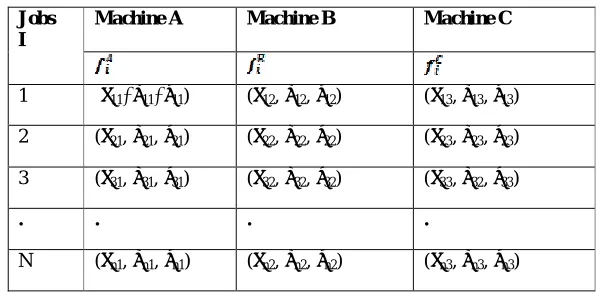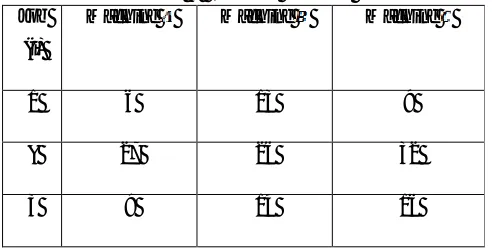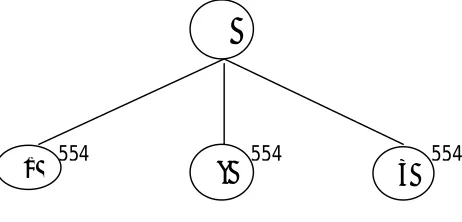Reseach article Available online www.ijsrr.org
ISSN: 2279–0543
International Journal of Scientific Research and Reviews
Optimization Of Operational Cost of Machines In Three Stage Flow
Shop Scheduling Using Branch and Bound Technique With Job Block
Gupta Deepak and Renuka
*Department of Mathematics, M.M. Deemed to be University, Mullana, Ambala, India. Email: renukajain7@gmail.com
ABSTRACT
In this paper, a study is made on scheduling of flow shop problem under uncertain
environment and an efficient branch and bound optimization technique for three machines is
proposed to find near-optimal schedule in a disturbance scenario. The processing time of all the jobs
on machines are uncertain and are presented by triangular membership function. Further a job block
for the three machines is introduced due to its applicability in the real world. The main aim of this
paper is to attain an optimal schedule, which minimizes the total operational cost of the machines.
Finally, computational results for this problem are provided to evaluate the performance of the
proposed algorithm.
*Corresponding author
Renuka
Department of Mathematics,
M.M. Deemed to be University,
Mullana, Ambala, India.
INTRODUCTION
Scheduling is a decision-making procedure that concerns the allotment of constrained assets
to an arrangement of assignments with the perspective of optimizing one or more objectives. In this
day and age of worldwide rivalry, effectual scheduling has turned out to be essential keeping in mind
the end goal to meet customer requirements as quickly as could be expected under the circumstances
while maximizing the profits. Scheduling in manufacturing systems is classically associated with
scheduling a set of jobs on a set of machines in order to maximize the profit. Manufacturing system
is mainly categorized as flow shop, job shop, and open shop. A typical flow shop problem contains n
jobs namely J1, J2, J3,…, Jn to be prepared through m machines M1, M2, M3, …Mm (Say). Technological constraints demand that each job should be processed through the machines in a
precise order and gives a critical extraordinary case termed as flow shop. However in reality, due to
the uncertainty of information as well as the variation of management scenario, it is often hard to get
the correct job processing time of all jobs. Thus, the ordinary methodologies, both deterministic and
random process, have a tendency to be less effective in conveying the imprecision or ambiguity
nature of the linguistic values. One alternative option to deal with this type of problem associated
with the processing time is to use fuzzy sets. In literature, several techniques were proposed for
managing uncertainty but to solve vague situations in real problems, the first systematic approach
related to fuzzy sets theory was recommended by Zadeh1 in 1965.Fuzzy set theory because of its
simplicity and similarity to human reasoning has numerous applications in various fields such as
engineering, pharmaceutical, manufacturing and others. Fuzzy numbers are applied to represent the
imprecise numerical measurements of different alternatives. McCahon and Lee2 discussed the job sequencing with fuzzy processing time. Ishibuchi and Lee3 addressed the formulation of fuzzy flow
shop scheduling problem with fuzzy processing time. Sanuja and Xueyan4 optimized the makespan in a two-machine flow shop problem in the presence of uncertainty and proved that their approach of
using different fuzzy sets determined by -cut of processing times is better than McCahon and
Lee2.Hong and Chuang5 developed a new triangular Johnson algorithm.Ignall and Scharge6 introduced branch and bound technique in flow shop scheduling problems. Some of the noteworthy
approaches are due toLomnicki7, Bagga8, Gupta JND9, Yager10, Marin and Roberto11, Yao and Lin12, Singh and Gupta13, Gupta, Aggarwal and Sharma14,15etc.
In this paper we have introduced a new job block parameter for three machines to solve fuzzy
scheduling problem under B & B approach. The idea of job block equivalent to a single job was first
to be charged extra from the priority customer(s) as compared to non-priority customer(s). If J1 and
J2 are two jobs, then ordered pair (J1, J2) is called a job block and designated by a single job. Further it is assumed that no more jobs can be processed in between J1 and J2 on all the machines and job J2 can be processed before J1 due to technological constraint.
There are many practical situations in real life when one has got the assignments but does not
have one’s own machine or does not have enough money or does not want to take risk of investing
huge amount of money to purchase machines. In this regard, the decision maker has totake machines
on rent in order to complete the assignments. For instance, care giving techniques often require
hi-tech, expensive medical equipment which are often needed for a few days or weeks thus buying them
do not make much sense even if one can afford them.
The rest of this paper is organized as follows:
In section 2, we recall the basic concepts of fuzzy numbers and their arithmetic operations. In
section 3, we have designed a mathematical model with the essential notations and assumptions used
throughout the paper. Section 4 introduces the operational policy. In section 5 we have proposed a
branch and bound algorithm with job block in order to minimize the operational cost of all the hired
machines. In section 6, a numerical example is provided to illustrate the algorithm developed in this
paper.Finally, we have given a conclusion at the end of this paper.
PRELIMINARIES
The aim of this section is to present some definitions based on fuzzy set and the various
arithmetic operations used on it which are useful in further considerations.
Definition
2.1
.
A fuzzy set defined on the set of real numbers R is said to be a fuzzy number if its membership function has the following characteristics:(i) is convex, that is (αx1 + (1 –α)x2) ≥ min{ (x1), (x2)}, for allx1, x2∈R and α ∈[0,1]. (ii) is normal i.e. there exists an x ∈R such that (x) = 1.
(iii) is piecewise continuous.
Definition2.2.
A fuzzy number on set of real numbersis said to be a triangular fuzzy number if its membership function has the following characteristics:1. (x) is a continuous mapping from R to closed interval [0,1].
2. (x) = 0 for every x ɛ (-∞,a]
4. (x) = 1 for every x = b
5. (x) is strictly decreasing and continuous on [b,c]
6. (x) = 0 for every x ɛ (c, ∞]
2.3. Fuzzy arithmetic operations
Let TF1= (α1,β1,γ1)and TF2 = (α2,β2,γ2) be two triangular fuzzy numbers. Then the arithmetic operations on these fuzzy numbers can be defined as follows:
1. Addition:TF1+TF2 = (α1+ α2, β1+ β2, γ1+ γ2)
2. Subtraction: TF1−TF2 = (α1− α2, β1− β2, γ1− γ2) if the following condition is satisfied DP(TF1) ≥ DP(TF2), where DP(TF1) = (γ1− α1) /2 and DP(TF2) = (γ2−α2)/2. Here DP denotes
difference point of a TFN.
Otherwise, TF1−TF2= (α1− γ2, β1− β2, γ1 − α2) 3. Equality : TF1=TF2 if α1= α2,β1= β2 , γ1= γ2
Multiplication: Suppose A = (a1, b1, c1) be any triangular fuzzy number and B = (a2, b2, c2) be
non-negative triangular fuzzy number, then we define:
4. max[(TF1), (TF2)] = TF1 if α1>α2; β1>β2 ; γ1>γ2
MODEL DESCRIPTION
This section provides some notations, assumptions and mathematical formulation of the
proposed model.
3.1. Model notations
Before presenting the model, it is necessary to introduce the various notations used in our
model. All are defined below:
Notations Description
Sequence obtained by applying branch and bound technique.
1 2 1 2 1 2 1
1 2 1 2 1 2 1 1
1 2 1 2 1 2 1
(a a , b b , c c ), a > 0;
A×B = (a c , b b , c c ), a < 0, c 0; (a c , b b , c a ), c < 0
Machine index,
Fuzzy Processing time of ith job on machine .
AHR of fuzzy Processing time of ith job on machine
Jr Any partial schedule of jobs.
J′r Any job from the set of jobs other than Jr. Lb[Jr,c] Lower bound on rental cost for schedule Jr RC[ ] Rental Cost on machine
3.2. Assumptions
1. There are no unplanned windows of non-availability for e.g. breakdowns, unplanned
maintenance, raw material shortage etc.
2. Splitting of job or job cancellation is not allowed.
3. Pre-emption is not allowed i.e. once a job is loaded on a machine, it cannot be removed until it
is complete.
3.3. Mathematical model formulation
Consider a three-stage flow shop scheduling problem with n jobs. Let
be the processing time of ith job (i=1,2,3….n) on machine X (X = A,B,C) described by triangular
fuzzy number. The mathematical model of the problem in matrix form can be stated as:
Table 1: Jobs with uncertain processing time
Jobs I
Machine A Machine B Machine C
1 (α11, β11, γ11) (α12, β12, γ12) (α13, β13, γ13)
2 (α21, β21, γ21) (α22, β22, γ22) (α23, β23, γ23)
3 (α31, β31, γ31) (α32, β32, γ32) (α33, β32, γ33)
. . . .
N (αn1, βn1, γn1) (αn2, βn2, γn2) (αn3, βn3, γn3)
Our objective is to acquire an optimal/near optimal schedule of jobs which minimize the total
OPERATIONAL POLICY
The operational policy is adopted when the machines are taken on rent or hired and the cost is
associated with the operational time of the machines. According to this policy, the machines will be
start its operation as and when they will be required and are stopped as and when they are no longer
required .i.e. the first machine will start operating in the starting of the job processing, second
machine will start its operation at time when first job is be completed on first machine and is in ready
mode for processing on second machine.
BRANCH AND BOUND ALGORITHM
Step1: Evaluate <AHR> of the given fuzzy processing time for all the jobs using Yager’s
formula.
Step2: Calculate the processing time for the equivalent job on the given three machines for a job
block ) in which is given priority over job is given as follows:
Job
Machine Machine Machine
where
Step3:Reduce the given problem into new problem by replacing‘ jobs by job block with
processing times , & on machines A,B & C respectively as defined in step 2.
Step4: Evaluate the values and for all the Schedules that begin with schedule = by the formula
defined as below:
(a) Define and Calculate ‘ ’ given by the following formula:
1 , 2 2 2 1 1 ' ' ' ) 2 , ( , min ) 1 , ( max i J i i r i J i J i i r t h J t l h h J t l l r r r
2 , 3 3 3 2 2 3 2 1 1 ' ' ' ' ' ) ( ) 3 , ( ), ( min ) 2 , ( ), ( min ) 1 , ( max i J i i r i J i J i i r i i J i J i i r t h J t L h h J t L h h h J t L L r r r r r
Wheret J( r,1),t J( r,2),t J( r,3) be the times at which machine X complete processing on the last of the
jobs in the sequence.
Step4:Obtain = lower bound on rental cost for schedule of flow shop problem which is
defined as follows:
Step 5: Choose minimum lower bound among all the unbranched nodes. Now explore
for the partial schedule of two jobs for the subclasses starting with above
searched node and again focus on the minimum node. Continuing in this way, till the complete
sequence is obtained and not reach at the end of the tree.
NUMERICAL ILLUSTRATION
To explain the working of the proposed algorithm, the following numerical illustration is
carried out. Consider 4 jobs, 3 machine flow shop problem with processing time described by
triangular fuzzy numbers as given in Table3. The operational costs per unit time for machines and
are Rs4 and Rs6 respectively and jobs are to be processed as an equivalent group job. Our
goal is to acquire an optimal/near optimal schedule, which minimizes the total operational cost of
machines under the predetermined operational policy.
Table 3: Data set for fuzzy processing time
Jobs
(i)
Machine Machine Machine
1 (4,5,7) (6,9,18) (5,7,12)
2 (20,25,26) (19,23,28) (22,24,25)
3 (8,10,17) (10,12,16) (11,14,17)
Solution:
The solution of the problem is formulated as follows:
The AHR of the given processing time on machines , and as per step 1 are shown in Table 4:
Table 4: AHR of fuzzy processing time
The processing time for the equivalent job δ for the job block (2,4) on the given machines are described as below:
Table 5: Reduced problem Job
(i)
Machine Machine Machine
1 6 13 9
δ 27 26 32
3 9 14 16
As per step 4, the calculated values of lower bounds for Jr =J1 using branch and bound technique are
given in Table 6:
Table 6: Evaluation of rental cost for
J1 l1 l2 L1 L2 L3 l L Lb[jr,c]
1 56 59 72 75 76 53 57 554
δ 55 80 64 89 110 53 57 554
3 55 62 64 71 80 53 57 554
Jobs
(i)
Machine Machine Machine
1 6 13 9
2 27 26 25
3 13 14 16
The corresponding scheduling tree for first level of nodes is shown as below:
Fig. 1 depict that all the lower bounds for first level of nodes produces the same operational
cost i.e.Lb[jr,c = 1] = Lb[jr,c = δ] = Lb[jr,c = 3] = 554. Hence there is no node having the least lower bound on operational cost. That is the reason we have considered all the nodes of first level as the
branching node in the scheduling tree for further proceeding.
Now take the partial schedule jr= j2 consisting of two jobs starting from the branching node.
The relevant operational costs estimation are given as in Table 7and graphically shown in Fig
no.2
Table 7: Evaluations of operational cost for
J1 l1 l2 L1 L2 L3 l L Lb[Jr,c]
1δ 56 73 72 89 107 40 48 448
13 68 59 100 91 51 53 67 614
δ1 56 80 72 96 110 47 44 452
δ3 55 80 64 89 110 44 43 434
31 68 62 100 94 106 53 70 632
3δ 55 75 64 84 103 39 41 402
1 δ 3
Φ
554 554 554
The corresponding scheduling tree is depicted as below:
Here, which is correspond to .
So the is the next branching node but we have considered as a equivalent job for a job
block . So by replacing the value of we obtained . Hence by the
technique of branch and bound we have scheduled the three nodes in a scheduling sequence among
the four nodes. In this way we acquired the complete sequence by placing the remaining node in
the last position that is with minimum operational Cost value
REFERENCES
1. Zadeh LA. Fuzzy sets. Information and Control.1965; 8:338-353.
2. Mc Cahon S and Lee ES.Job sequencing with fuzzy processing times.Computer and
Mathematics with Applications. 1990;19(7): 31-41.
3. Ishibuchi H and Lee KH. Formulation of fuzzy flow shop scheduling problem with fuzzy
processing time.Proceeding of IEEE International Conference on Fuzzy System.1996;
199-205.
4. Sanuja P and Xueyan SA. New approach to two machine flow shop problem with uncertain
processing time. Optimization and Engineering. 2006; 7(3): 329–343.
5. Hong T, and Chuang T.New triangular fuzzy johnson algorithm. Computer and Industrial
Engineering. 1999;36(1): 179–200. 554
3 554 554
1 δ
φ
614 452
δ3
δ1
434 402
3δδ
31
632
1δ 13
448
241
434
311 324
402 632
243 1242
22
13
448 614 452
Optimal Sequence = {3,2,4,1}
6. Ignall E and Schrage L. Application of the branch-and-bound technique to some flowshop
scheduling problems. Operations Research.1965;13: 400-412.
7. Lomnicki ZA. A branch-and-bound algorithm for the exact solution of the three-machine
scheduling problem.Operational Research Quarterly.1965;16:.89-100.
8. Bagga PC. Sequencing in a rental situation.Journal of CandianOperations Research
Society.1969; 7:152-–163.
9.
Gupta JND. Optimal schedule for specially structured flow shop.Naval Research Logistic.1975; 22(2): 255–269.
10. Yager RR. A procedure for ordering fuzzy subsets of the unit interval.Information
Sciences.1981; 24:143-161.
11. Marin L and Roberto T. Fuzzy scheduling with application to real time systems. Fuzzy Sets
and Systems. 2001;121(3): 523–535.
12. Yao JS and Lin FT.Constructing a fuzzy flowshop sequencing model based on statistical
data. International Journal of Appropriate Reasoning. 2002;29(3): 215–234.
13. Singh TP and Gupta D. Minimizing rental cost in two stage flow shop, the processing time
associated with probabilities including job block. Reflections de ERA. 2005;1(2): 107–120.
14. Gupta D, Aggarwal S and Sharma SA. Fuzzy logic based approach to minimize rental cost of
machines for specially structured three stages flow shop scheduling. Advances in Applied
Science Research.2012; 3(2):1071-1076.
15. Gupta D, Aggarwal S. and Sharma S. Bi-criteria three stage fuzzy flow shop scheduling with
transportation time and job block criteria.International Journal of Applied Operational
Research. 2013; 2(4): 41-53.
16. Maggu PL and Das G. Equivalent jobs for job block in job scheduling. Journal of Operations



